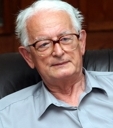Dénes Vargha
In the autumn of 1962, the computational linguistics group was established at the Hungarian Academy of Sciences' Computer Science Center (MTA SZK) with Ferenc Kiefer, Dénes Vargha, Sándor János Petőfi and three part-time researchers. In the meantime, he obtained a PhD degree in linguistics in the Soviet Union. The SZK computational linguistics group became an independent research group of the SZK in 1963, which operated until 1972.
From 1972, he worked at the National Planning Office, and then in the 1980s at the National Technical Information Center and Library (OMIKK).
From 1962, the multi-part journal Computational Linguistics was published annually in Budapest, initially edited by the Hungarian Academy of Sciences, and the research group formed around it included linguists, mathematicians and representatives of other scientific fields. This is where the development of Hungarian computational linguistics began. Among our linguists were Ferenc Papp, Ferenc Kiefer, György Szépe, Sándor János Petőfi, and others, and among computer experts Dénes Vargha, Éva Szöllősy, and Mária Stein. The discipline soon took on university frameworks: Ferenc Kiefer and György Szépe launched the Mathematical Linguistics department at the Faculty of Humanities of ELTE in the 1962/63 academic year.
In 1963, Dénes Vargha published his book “Algorithms for the Analysis of Russian-Language Texts”, written in collaboration with György Hell, Ferenc Kiefer, and Győző Sipőczy. In 1966, he edited the first Hungarian collection of excerpts on this topic, “Linguistic Questions of Documentation.”; in 1969, he also published a sequel to the work. He also published in the journal Scientific and Technical Information; his study dealing with issues of machine translation is memorable.
In 1976, he participated in the development of the MSZ 3418 thesaurus standard, which has remained one of the most up-to-date normative documents of this kind ever since.
In 1969, the Hungarian version of his Russian-language candidate's dissertation, entitled "Methodology for Creating Information Seeking Thesauri", was published, which also included basic theoretical knowledge.
Between 1985 and 1990, he was the head of the Computational Linguistics and Text Processing Department of the National Institute of Languages and Literatures.
In 1988, he organized the international Coling conference in Budapest; he edited the conference publication. During these years, he was also interested in the relationship between artificial intelligence (AI) and computational linguistics.
- He has several famous brothers; among them we mention the writer Domokos Vargha and the mathematician and teacher Tamás Vargha.
Created: 2018.06.28. 15:06
Last modified: 2024.03.26. 21:01

